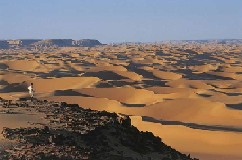By Kayla Allen
The second largest desert in the world, second only to Antarctica, the Sahara desert takes up about a third of the continent of Africa and is roughly the size of the continental U.S.
The boundaries of the Sahara are the Atlantic Ocean on the west, the Atlas Mountains and the Mediterranean Sea on the north, the Red Sea and Egypt on the east, and the Sudan and the valley of the Niger River on the south. The Sahara divides the continent of Africa into North and Sub-Saharan. The southern border of the Sahara is marked by a band of semiarid savanna called the Sahel; south of the Sahel lies the lusher Sudan and the Congo River Basin.
The Sahara's climate can be divided into two climates, a dry sub-tropical climate in the north and a dry tropical climate in the south.

The dry tropical climate is generally characterized by mild, dry winters and a hot dry season just before the rainy season. The average temperature in this region is about 31.5 Degrees F (17.5 Degrees C), however in the higher elevations, the temperature has been recorded at 5 Degrees F (-15 Degrees C), which is quite typical. The average annual precipitation is around five inches and includes snow in the higher elevations.
The desert's dry, sub-tropical climate is characterized by cold winters, hot summers and two rainy seasons. The highest recorded temperature in the Sahara is 130 degrees. Even with two rainy seasons this part of the Sahara rarely sees more than 3 inches of rain a year.
Humans have lived on the edge of the desert for almost 500,000 years. Imediately after the last ice age, the Sahara was a much wetter place than it is today. Over 30,000 petroglyphs of river animals such as crocodiles survive in total with half found in southeast Algeria.
Fossils of dinosaurs have also been found here. The modern Sahara, though, is not as lush in vegetation, except in the Nile Valley, at a few oases, and in the northern highlands, where Mediterranean plants such as the olive tree grow. It has been this way since about 3000 BCE.
The Sahara Desert covers over 3.5 million square miles and has only 2.5 million inhabitants – roughly 1 person per square mile, which is one of the lowest population densities on earth. Wherever abundant food and water sources occur, one will find relatively large masses of people and wildlife. Most of the Sahara's inhabitants live in Egypt, Mauritania, Morocco and Algeria. The largest city in the Sahara is Cairo, in the Nile Valley and Egypt's capital. On the whole, the Sahara is one of the harshest environments known to man.
For more information please visit my resources:
Thinkquest
Wikipedia



 ShareThis
ShareThis
